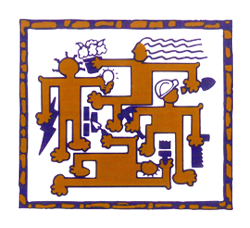
Hawaii’s trade winds are well known for the breezes that gently blow across the islands. But there are no trade winds on the Kona Coast. In Kona, the typical weather pattern starts with an early morning downslope breeze that transitions into a late morning / early afternoon upslope, with wind and cloud cover along with rain in the late afternoon upper elevations. If you are considering building a new home in Kona, Hawaii, there are ways to take advantage of the variations in wind patterns to keep your home cool without using air conditioning.
When possible, stretch your home design parallel with the coast. This makes it easier to get fresh air into every room by not blocking the flow with walls. Place windows and doors on the inland (mauka) and coastal (makai) walls. Big objects like refrigerators and beds can go against north and south walls. Casement windows which swing like doors can also be used on these north /south walls to scoop air inside.
Don’t block the flow of air with solid walls. Use doorways, halls and great rooms to channel the breeze through the interior space.
Deep roof overhangs, awnings and Lanai covered roofs shade windows and sliding glass doors. Thirty-inch minimum overhang is needed, but thirty-six inches is better, while an even deeper projection of forty-eight inches also helps keep wind driven rain out of the house.
Tree placement to shade the roof, but not solar panels. Along with shading driveways and patios to prevent reflecting heat bouncing towards the house, trees provide a natural source of shade around the house. West facing landscapes can also protect by casting a shadow in late afternoon, as well as using hedges near stucco walls to stop heat retention.
Roofs can be insulated from heating your attic by using “Techshield” foil faced roof plywood sheathing. Combine with ceiling insulation and the choice of a reflective roof such as coated metal instead of a heat absorbing asphalt shingle or concrete tile.
Windows with “Low-E” or similar rating are great at reflecting heat and ultraviolet light. However, your windows are supposed to be open ALL the time. After all we live in Hawaii. So, maximize window space. Don’t worry about triple layer glass, etc. A basic window works well in Hawaii.
Air conditioning use should be kept to a minimum if at all. Consider using zones for bedrooms used by visitors. You will NEVER close up your home in Hawaii. You will NEVER run the A/C all day. Complete A/C systems cost $40,000+ for a home and $20,000 for a condo. Individual bedrooms can be controlled separately and installed for less than half the cost quoted. Air conditioning is for tourists cooling down from a day’s activities or possibly sleeping, then back out into the natural climate. Hawaii’s energy prices are the highest in the nation. If you must have A/C, try to power with solar panels. This is a great place to use photovoltaic systems.
Interior window shades and exterior roll up blinds are popular for late afternoon heat gain on lanais. Motorized versions need an electrical outlet and are usually remote controlled. They do block the view though just before the critical sunset and elusive green flash!
High ceilings inside and out keep hot air from seeping through the attic drywall into the living space. When planning your new home, insist on nine feet minimum for the ceiling height. Ten feet is better yet, and be sure the windows extend upward to allow that heat to depart.
Ceiling fans are commonly used everywhere including Lanais. Often fans are not really needed but good for sleeping during the warmest months. Remember: fans don’t cool the room. They cool the individual in it. Having fans on when you’re not in the room waste energy if you’re not in that space.


